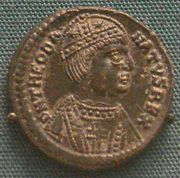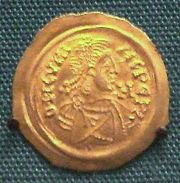Odoacer
| Odoacer | |
|---|---|
| King of Italy | |
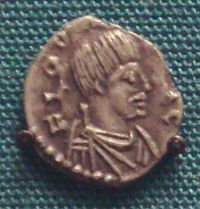 |
|
| Coin of Odoacer, Ravenna, 477, with Odoacer in profile, depicted with a "barbarian" moustache. | |
| Reign | 476 - 493 |
| Predecessor | Romulus Augustus |
| Successor | Theodoric the Great |
| Father | Edeko |
| Died | 493 Ravenna |
Odoacer (435–493) , also known as Odovacer, was the 5th-century King of Italy, whose reign is commonly seen as marking the end of the classical Roman Empire in Western Europe and the beginning of the Middle Ages. He is considered the first non-Roman to have ruled Italy.
Odoacer was a Germanic foederati general in Italy who led a revolt that deposed the last Western Roman Emperor, Romulus Augustus on 4 September AD 476. Though the real power in Italy was in his hands, he ruled as a nominal client of Julius Nepos and, after Nepos' death in 480, as a client of the Emperor in Constantinople. Odoacer is referred to as a king (Latin rex) in many documents, but the title appears to be informal, though he himself used it at least once and on another occasion it was used by the consul Basilius.[1]
Contents |
Background
Odoacer's background is not certain. He may have been the son of the Scirii chieftain, Edeko, a vassal of the Huns under Attila. His name itself is Germanic, and Odoacer's mother may have been Germanic herself, but her name and nationality are unknown. John of Antioch considers Odoacer to have been a Scirian, Jordanes refers to him as a Rugian. However, Jordanes also describes him as king of the Turcilingi (Torcilingorum rex).[2] The Consularia Italica calls him king of the Heruli, while Theophanes appears to be guessing when he calls him a Goth.[3]
Leader of the foederati
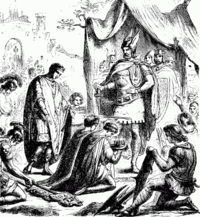
In 470, Odoacer was appointed leader of a band of foederati. There were about 30,000 foederati, plus their families, who had lived on the Italian peninsula for several years. However, they had only received scraps of land in relatively unfertile areas around the Apennine mountains.
When Orestes was in 475 appointed Magister militum and patrician by the Western Roman Emperor Julius Nepos, he became head of the Germanic foederati of Italy (the Scirian - Herulic foederati). To win their support in his attempt to take over the Empire, Orestes promised them a third of the Italian peninsula if they led a revolt against Emperor Nepos. The foederati accepted the offer and led the revolt as planned.
On 28 August 475, they defeated Nepos, who fled to Dalmatia. Orestes then elevated his young son Romulus to the rank of Augustus, to become emperor as Romulus Augustus. Orestes, as magister militum, then organized his own army. He felt secure enough to rescind his pledge to the foederati. Odoacer then led the foederati in a revolt against Orestes, who was defeated, captured and executed. After the revolt, the Germanic foederati, the Scirians and the Heruli, as well as a large segment of the Italic Roman army, proclaimed Odoacer rex Italiae ("king of Italy").[4] In 476, Odoacer then advanced to Ravenna, captured the city and the young emperor. Romulus was compelled to abdicate on 4 September 476, but otherwise unharmed.
In the same year Odoacer renounced the meaningless title of Emperor, avoiding a conflict with Constantinople. He sent the imperial insignia to the Eastern Emperor Zeno and declared himself Patrician of the Western half, which by this time was no more than the Italian peninsula, Dalmatia and an exclave in northern Gaul. The rightful Western Roman Emperor, Julius Nepos, ruled powerless in Dalmatia, where he would live until his assassination in 480. During this four-year interval Odoacer recognized Nepos as Western emperor and even made coins in his name.
King of Italy

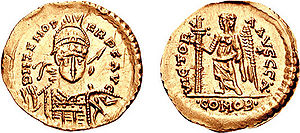
In 476, Odoacer officially became the first Germanic King of Italy and a new era began. Odoacer was an Arian Christian and is said to have been illiterate. The warriors and the families in Odoacer's foederati received lands in Italy and became beneficiaries of a special tax policy. Odoacer retained the Roman administration, senate, law and tax system of Italy. In return, he won a high level of support from the senate and people.
Odoacer raised an Italic-Germanic army with which he defeated the Vandals in Sicily. He was able to conquer the whole island by 477. By 480, he and his Italic-Germanic army annexed all of ancient Dalmatia, after the death (possibly by assassination) of Western Emperor Julius Nepos. After this, he received the right to appoint a council and to issue his own coinage. He made pacts with the Visigoths and Franks and joined them in battle against the Burgundians, Alamanni, and Saxons.
As Odoacer's kingdom expanded, his popularity among the Italic people grew, and his pacts with the Franks and Visigoths gave him increased influence. All these things started to worry Zeno, the Eastern Emperor, who increasingly saw Odoacer as a rival. In 487 Odoacer led his army to victory against the Rugians in Noricum, but he did not incorporate it into his own kingdom. The remaining Rugians fled and took refuge with the Ostrogoths. Rugiland was left open and by 493 was settled by the Lombards. In 488, Emperor Zeno started a mostly verbal campaign against Odoacer, accusing him of playing a major part in the revolt of Illus in 484. With these claims, Zeno convinced his Ostrogothic vassals that Odoacer was an enemy and should be removed. Zeno promised Theodoric the Great and his Ostrogoths the Italian peninsula if they were to defeat and remove Odoacer. In the same year, 488, Theodoric led the Ostrogoths across the Julian Alps and into Italy. With this betrayal, the Byzantines killed two birds with one stone. They removed the Ostrogoths from the Balkans and their border and at the same time conveniently caused Odoacer to disappear from the scene.
Death
Theodoric and his Ostrogoths defeated Odoacer at Aquileia in 488, at Verona in 489, and at the Adda River in 490. In that same year, Theodoric besieged Odoacer at Ravenna. The siege lasted three years and was marked by dozens of attacks on both sides. In the end, neither side could conclusively prevail, and so on 2 February 493, Theodoric and Odoacer signed a treaty that ensured a shared rule over Italy. A banquet was organized in order to celebrate this treaty. It was at this banquet that Theodoric, after making a toast, killed Odoacer with his own hands.
Theodoric became the new king of Italy and established an Ostrogothic kingdom that was ruled from Ravenna. The remainder of Odoacer's foederati joined the Ostrogoths and were allowed to remain in Italy. Many of the fathers of these warriors and a number of the warriors themselves had fought together with the Ostrogoths at the Battle of Nedao in 454.
The events around the Battle of Ravenna were used in the Germanic heroic saga of Dietrich von Bern (Theodoric of Verona). The event in which Theodoric kills Odoacer with his own hands is mirrored in the saga in the episode in which Dietrich kills the Dwarf King Laurin.
Notes
- ↑ Marcellinus, Cassiodorus, and some Papal documents, which come the closest to implying officiality of the title, all refer to him as rex (or one of its declensions). Jordanes at one point refers to him as Gothorum Romanorum que regnator: ruler of the Goths and the Romans. He is called an autokrator (autocrat, dictator) and a tyrranos (usurper, tyrant) in Procopius' Bellum Gothicum. The only reference to Odoacer as "King of Italy" is in Victor Vitensis: Odouacro Italiae regi.
- ↑ Jordanes (1908). The origin and deeds of the Goths, in English version. Princeton University. p. 75.
- ↑ McGeorge, Penny (2002). Late Roman warlords. Oxford University Press. p. 284. ISBN 9780199252442.
- ↑ Edward Gibbon, The Decline and Fall of the Roman Empire, Volume I, Chap. XXXVI (Chicago: Encyclopaedia Britannica, Inc., 1952), p. 590.
Sources
- Thompson, E. A. Romans and Barbarians: The Decline of the Western Empire. Madison: University of Wisconsin Press, 1982. ISBN 0 299 08700 X.
| Preceded by Romulus Augustus as Western Roman Emperor |
King of Italy 476–493 |
Succeeded by Theodoric the Great |
|
||||||||||||||||||||||
